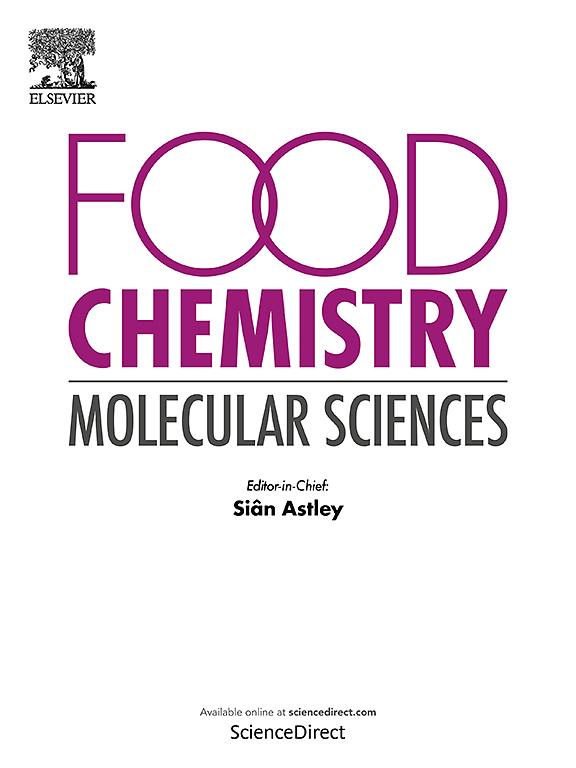Characteristics and bioinformatics of peptides from natural and cultured sandfish (Holothuria scabra)
IF 4.1
Q2 FOOD SCIENCE & TECHNOLOGY
引用次数: 0
Abstract
This study aimed to investigate the characteristics and bioinformatics identification of peptides in sandfish (Holothuria scabra) protein hydrolysate from natural and cultured sources, with the hypothesis that different sources of sandfish and enzymatic treatments would result in distinct peptide profiles. Sandfish from both sources were subjected to double enzymatic hydrolysis using neutral protease–alcalase (NA), papain–neutral protease (PN), and papain–alcalase (PA) to obtain protein hydrolysates. The hydrolysates were analyzed for amino acid composition, protein molecular weight distribution, functional groups using FTIR spectroscopy, LC-MSMS analysis coupled with bioinformatics for protein and peptide identification, and mineral profile. The resulting hydrolysates exhibited similar amino acid profiles, characterized by high levels of glycine, alanine, glutamic acid, and aspartic acid. The functional groups of the sandfish protein hydrolysates were primarily found at wavenumbers 1658 cm−1 (amide I), 1541 cm−1 (amide II), and 1246 cm−1 (amide III). Peptides with molecular weights below 500 Da predominated in every sample, highlighting their small molecular size. LC-MSMS analysis, coupled with bioinformatics database comparisons, indicated that sandfish from natural and cultured sources, as well as different enzymes used in the hydrolysis process, significantly affect protein and peptide pattern. Of the 2132 identified proteins, 1258 exhibited significant differences (p < 0.05, FDR < 0.05). This study provides insights into how source and enzymatic treatment influence peptide profiles, which could be applied in the development of functional ingredients or bioactive peptides from sandfish.
天然和养殖沙鱼多肽的特性及生物信息学研究
本研究旨在研究天然和人工沙鱼(Holothuria scabra)蛋白水解产物中肽的特征和生物信息学鉴定,并假设不同来源的沙鱼和酶处理会产生不同的肽谱。采用中性蛋白酶-碱性酶(NA)、木瓜蛋白酶-中性蛋白酶(PN)和木瓜蛋白酶-碱性酶(PA)对这两种来源的沙鱼进行双重酶解,得到蛋白质水解产物。利用FTIR光谱分析水解产物的氨基酸组成、蛋白质分子量分布、官能团,利用LC-MSMS结合生物信息学分析蛋白质和肽,以及矿物谱。所得到的水解产物表现出相似的氨基酸谱,其特点是高水平的甘氨酸、丙氨酸、谷氨酸和天冬氨酸。沙鱼蛋白水解产物的官能团主要在波数1658 cm−1(酰胺I)、1541 cm−1(酰胺II)和1246 cm−1(酰胺III)上发现。每个样品中分子量低于500 Da的肽占主导地位,突出了它们的小分子大小。LC-MSMS分析结合生物信息学数据库的比较表明,天然和人工养殖的沙鱼以及不同的酶在水解过程中对蛋白质和肽的模式有显著影响。在鉴定的2132个蛋白中,1258个表现出显著差异(p <;0.05, FDR <;0.05)。该研究提供了来源和酶处理如何影响肽谱的见解,可用于从沙鱼中开发功能成分或生物活性肽。
本文章由计算机程序翻译,如有差异,请以英文原文为准。
求助全文
约1分钟内获得全文
求助全文
来源期刊

Food Chemistry Molecular Sciences
Agricultural and Biological Sciences-Food Science
CiteScore
6.00
自引率
0.00%
发文量
83
审稿时长
82 days
期刊介绍:
Food Chemistry: Molecular Sciences is one of three companion journals to the highly respected Food Chemistry.
Food Chemistry: Molecular Sciences is an open access journal publishing research advancing the theory and practice of molecular sciences of foods.
The types of articles considered are original research articles, analytical methods, comprehensive reviews and commentaries.
Topics include:
Molecular sciences relating to major and minor components of food (nutrients and bioactives) and their physiological, sensory, flavour, and microbiological aspects; data must be sufficient to demonstrate relevance to foods and as consumed by humans
Changes in molecular composition or structure in foods occurring or induced during growth, distribution and processing (industrial or domestic) or as a result of human metabolism
Quality, safety, authenticity and traceability of foods and packaging materials
Valorisation of food waste arising from processing and exploitation of by-products
Molecular sciences of additives, contaminants including agro-chemicals, together with their metabolism, food fate and benefit: risk to human health
Novel analytical and computational (bioinformatics) methods related to foods as consumed, nutrients and bioactives, sensory, metabolic fate, and origins of foods. Articles must be concerned with new or novel methods or novel uses and must be applied to real-world samples to demonstrate robustness. Those dealing with significant improvements to existing methods or foods and commodities from different regions, and re-use of existing data will be considered, provided authors can establish sufficient originality.
 求助内容:
求助内容: 应助结果提醒方式:
应助结果提醒方式:


